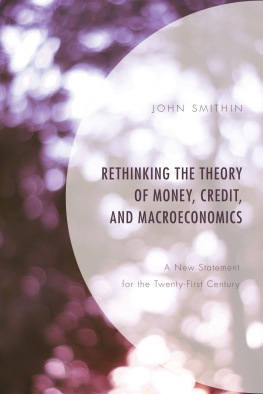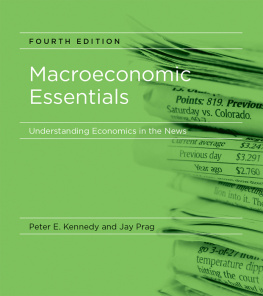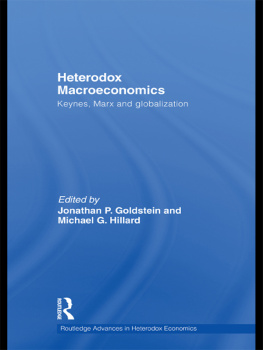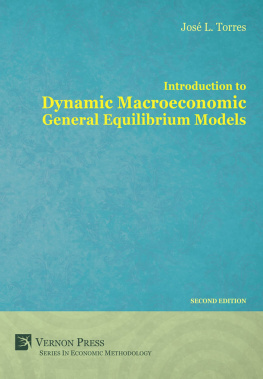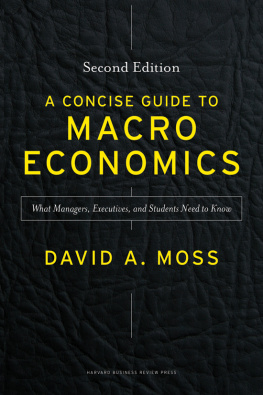Preface
This book offers an introduction into modern, mainstream macroeconomic theory. It is designed to be concise, accessible, and broad.
Audience The target audience are master students or beginning doctoral students in economics who are familiar with microeconomics and calculus at the undergraduate level. The text may also serve as a reference for more advanced readers.
Structure Models help organize ones thinking. The book attempts to organize models and to show how they build on and relate to each other. The design is decidedly bottom-up: Models of individual decision making are covered prior to models of general equilibrium, which in turn are covered prior to positive and normative theories of government and economic policy. Simplerand often, the simplest possibleenvironments are analyzed before more complex settings. And models without frictions precede models with frictions.
Contents Chapter 1 reviews the microeconomic foundations of macroeconomics and discusses the primitives of an economic model. Chapter 2 analyzes the dynamic optimization problem of a household with a finite or infinite horizon and consistent or inconsistent preferences, which consumes a single or multiple goods. Chapter 3 embeds the household problem in the two workhorse models of dynamic general equilibrium theorythe representative-household model and the overlapping generations modeland analyzes the efficiency properties of equilibrium.
Chapter 4 introduces risk and studies the implications for household choices and macroeconomic outcomes when markets are complete or incomplete. Chapter 5 analyzes equilibrium asset returns and prices as well as bubbles. Chapter 6 introduces labor supply choice along the intensive and extensive margin and studies wage and consumption inequality; the chapter also covers growth and business cycles, both technology- and sunspot-driven. Chapter 7 introduces open economy issues including the current account, the real exchange rate, and gains from trade.
Chapter 8 introduces frictions and analyzes their macroeconomic consequences: The chapter covers convex and nonconvex capital adjustment costs; matching frictions in the labor market; and frictions in financial markets, which give important roles to net worth, collateral, and pecuniary externalities. Chapter 9 focuses on models of money as a unit of account, store of value, and medium of exchange. Chapter 10 analyzes price setting by monopolistically competitive firms and the macroeconomic consequences of price rigidity.
The last three chapters focus on the government and economic policy. Chapter 11 covers the macroeconomic effects of tax, debt, social security, and monetary policy; equivalence relations between policies; fiscal-monetary policy interaction; and the determinacy of inflation and output. Chapter 12 characterizes optimal (Ramsey) fiscal and monetary policies. Chapter 13 analyzes sequential policy choice in (politico-economic) equilibrium with applications to capital income taxation, sovereign debt and default, politically motivated redistribution, and monetary policy biases.
Mathematical Tools and Technical Discussions Appendix A collects mathematical tools for optimization and the analysis of dynamic systems. Appendix B contains discussions about transversality conditions; the representative household construct; nonexpected utility; linear rational expectations models; Ramsey taxation; and probabilistic voting.
Literature and Related Topics Bibliographic notes at the end of each chapter point to classic articles and other related papers. They also touch upon topics that are connected with the material but not discussed in the chapter and they indicate when other textbooks cover the material in more detail. The hope is that this helps the reader to gain an overview of the field.
Style Conciseness was a key objective. Nevertheless, the text is self-contained and generally includes derivations of the results. When these derivations are missing, then they are most likely the subject of an exercise (see below).
Exercises and Additional Material A companion text with exercises for all chapters is available on the authors website, www.niepelt.ch/book; the solutions manual may be obtained from the publisher. The website also points to computer code and other useful (teaching) material as well as to a list of typos and corrections. Links and content will be updated over time in response to helpful critique and suggestions.
Theory and Measurement The book focuses on theoretical modelsformal, abstract parables that are internally consistent and convey general insights. It has nothing to say about the data. (What passes as a stylized fact may change over time and be country specific.)
To meaningfully confront abstract parables with real-world macroeconomic data requires a sound understanding not only of theory, which the text is about, but also of data sources, aggregation, and econometric methods, which it is not.
Teaching The book grew out of lecture notes for MA and PhD courses taught at European universities. It focuses on theory (see above) and lecturers using the text in class will likely opt to supplement the theory with real-world examples.
A one-semester, two-hour-per-week introduction to macroeconomics may be based on material in chapters 13 as well as selected topics covered in chapters 47.
One-semester advanced courses may be based on the remaining topics from chapters 47 or on material covered in chapters 810.
A one-semester advanced course on government and economic policy may follow selected sections in chapters 1113.



